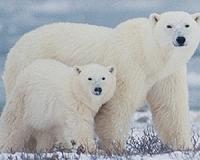| . |  |
. |
Washington (AFP) Feb 16, 2011 Global warming could cause up to 60 percent of the world's permafrost to thaw by 2200 and release huge amounts of carbon into the atmosphere that would further speed up climate change, a study released Wednesday warned. Using projections based on UN Intergovernmental Panel on Climate Change (IPCC) scenarios, scientists at the National Snow and Ice Data Center (NSIDC) in Colorado estimated that if global warming continues even at a moderate pace, a third of the earth's permafrost will be gone by 2200. If the planet warms at a faster pace, the world could see 59 percent of the permanently frozen underground layer of earth thaw out; as that happens, organic matter that has been trapped in the permafrost for tens of millennia will begin to decay, releasing carbon into the atmosphere. The NSIDC scientists then used a model to predict how much carbon the thawing permafrost would release and came up with the staggering figure of 190 gigatons by 2200. "That's the equivalent of half the amount of carbon that has been released into the atmosphere since the dawn of the industrial age. That's a lot of carbon," NSIDC scientist Kevin Schaefer, the lead author of the study, told AFP. A gigaton is one billion tons, so 190 gigatons is the equivalent of around a billion tons of carbon entering the atmosphere each year between now and 2200. Schaefer said carbon that would be released from melting permafrost has to be accounted for in global warming strategies. "If we don't account for the release of carbon from permafrost, we'll overshoot the C02 concentration we are aiming for and will end up with a warmer climate than we want," he said. But all was not doom and gloom, he said. "If we start cutting emissions now, we will slow down the thaw rate and push the start of this carbon release off into the future," he said. In a study published in 2009, University of Florida ecology professor Ted Schuur used a different method to study the effect of thawing permafrost on atmospheric carbon and arrived at the same annual figure for carbon entering the atmosphere as Schaefer and his co-authors. Some argue that the loss of permafrost would not present a significant threat to the planet, as plants would start to grow on the warmer earth and suck in carbon dioxide from the atmosphere through photosynthesis, thus blunting the problem. But Schuur said in his study two years ago that protection from plant growth "doesn't last, because there is so much carbon in the permafrost that eventually the plants can't keep up." Schaefer insisted that a major preventive effort, starting now, could stave off the worst-case scenario of rapidly melting permafrost releasing huge amounts of carbon dioxide into the atmosphere and further accelerating global warming and permafrost melting.
Share This Article With Planet Earth
Related Links Beyond the Ice Age
 Polar Bear Births Could Plummet With Climate Change
Polar Bear Births Could Plummet With Climate ChangeEdmonton, Canada (SPX) Feb 16, 2011 University of Alberta researchers Peter Molnar, Andrew Derocher and Mark Lewis studied the reproductive ecology of polar bears in Hudson Bay and have linked declining litter sizes with loss of sea ice. The researchers say projected reductions in the number of newborn cubs is a significant threat to the western Hudson Bay polar-bear population, and if climate change continues unabated the v ... read more |
|
| The content herein, unless otherwise known to be public domain, are Copyright 1995-2010 - SpaceDaily. AFP and UPI Wire Stories are copyright Agence France-Presse and United Press International. ESA Portal Reports are copyright European Space Agency. All NASA sourced material is public domain. Additional copyrights may apply in whole or part to other bona fide parties. Advertising does not imply endorsement,agreement or approval of any opinions, statements or information provided by SpaceDaily on any Web page published or hosted by SpaceDaily. Privacy Statement |